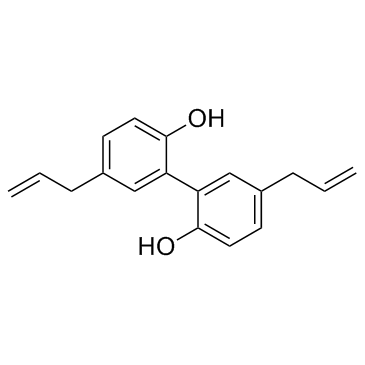Magnolol
| CAS No. | 528-43-8 | Cat. No. | BCP28276 |
| Name | Magnolol | ||
| Synonyms | Dehydrodichavicol; 5,5'-Diallyl-2,2'-dihydroxybiphenyl; 5,5'-Diallyl-2,2'-biphenyldiol; | ||
| Formula | C18H18O2 | M. Wt | 266.32 |
| Description | Magnolol, a natural lignan isolated from the stem bark of Magnolia officinalis, is a dual agonist of both RXRα and PPARγ, with EC50 values of 10.4 µM and 17.7 µM, respectively.Magnolol is known to act on the GABAA receptors in rat cells in vitro as well as having antifungal properties. Magnolol has a number of osteoblast-stimulating and osteoclast-inhibiting activities in cell culture and has been suggested as a candidate for screening for anti-osteoporosis activity. It has anti-periodontal disease activity in a rat model. Magnolol is a bioactive compound found in the bark of the Houpu magnolia (Magnolia officinalis) or in M. grandiflora. The compound exists at the level of a few percent in the bark of species of magnolia, the extracts of which have been used in traditional Chinese and Japanese medicine. In addition to magnolol, related lignans occur in the extracts including honokiol, which is an isomer of magnolol. | ||
| Pathways | Protease/Metabolic Enzyme Cell Cycle/DNA Damage | ||
| Targets | RAR/RXR PPAR | ||
Structure

Part data of this page collected from the open network resources, so Biochempartner can not guarantee its accuracy.
For product details of different batches, please contact our Customer
- Service & Tech Support:orders@biochempartner.com
- Website:www.biochempartner.com
Products are for research use only and not for human use. We do not sell to patients.
